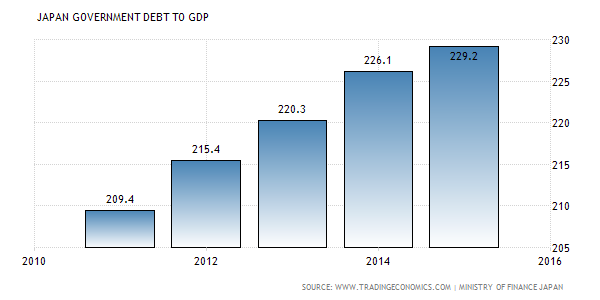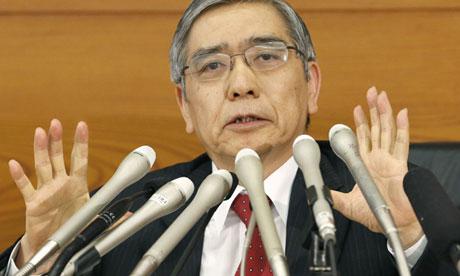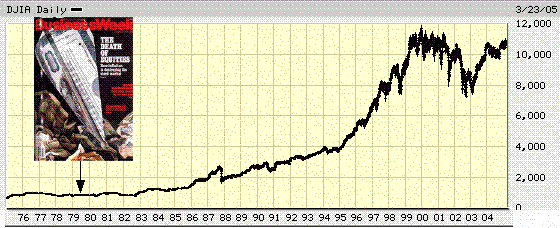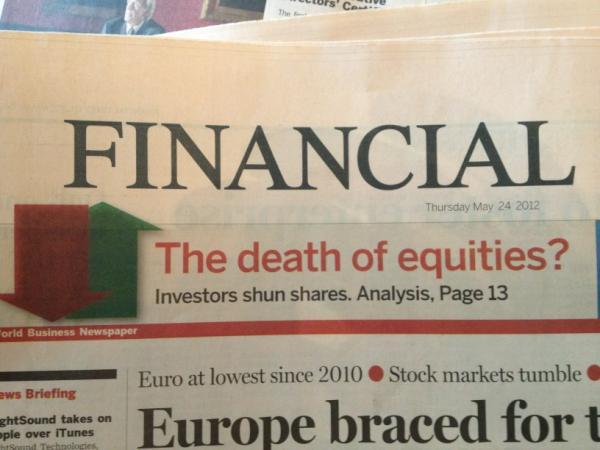BoJ officials are going about this in the wrong way, as if they are walking backwards into their meetings and looking in the opposite direction of the Japanese economy.
From the top
Let's get something very clear first of all and go back to the beginning. Since the 1990's, Japan has been in a recession and in my opinion they have never really recovered. Yes, they have constantly been trying to prop up the stock market and the economy at a rate equal to their liabilities while desperate to keep the export engine running, yet, as the years have gone by, other nations around them were growing, yet Japan keeps plunging and debt keeps multiplying:

The Japanese banking system is like taking a walk through an overgrown graveyard and the tiring government has been carrying around that dead weight for such a long time now. But, yet for some reason, that I really can't grasp a hold of, investors are putting confidence in the nations tactics and suggest that Japan is the greatest example of how printing money has worked for the nation. Well, if we are going to use Japan as an example for anything, I believe that Japan is the perfect example of the failure of QE and all other nations that have adopted this policy should take heed.
Let's look at the BoJ's tactics...
Japan is looking at increasing QE again and decreasing interest rates - doing whatever it takes to beat deflation. "The central bank remains unwavering in its determination to do whatever it takes to overcome deflation and achieve its 2% inflation target," explained Kuroda.

Source: The Guardian
You can't bring the interest down without distorting the markets
Before zero interest rates came a long recently, the BoJ had started QE on a huge scale a few years ago that made them the dominant buyer on the $9T JGB market. But, as we all should understand by now, what this really means is that the Central Bank is stock pilling the nations debt, and hoping that somebody will be able to buy it all up at a later date. They had been doing the same thing with the stock market as well, considering all this junk as assets - Go figure? I mean, that is one vault the boys at Oceans 11, 12 and 13 would want to avoid I'm sure!

BoJ policy failing - nope, has already failed
Their own policies are failing them and we only need to look at the how driving interest rates below zero, the BoJ has turned the JGB market into a circus that has knotted everything up for the Central Bank as prices swing wildly because prices below zero yields confound investor's attempts to find a fair market value.
So, in effect, this policy has already backfired on them as they try to untangle this mess before they can even get back to what their actual initial intentions were; To kick-start growth and end deflation.
But, there is a bigger problem with zero interest rates, and it is one everyone should be concerned with. The Central Banks, whether its China, Japan or the Fed, once again they are on the way to creating a bubble that has happened several times before and when that happens, you will see investors lose all confidence in the stock markets when they crash again.
We will be seeing again, that 'BusinessWeek' cover story entitled “The Death of Equities.” after the Burns/Nixon cheap-money episode when the U.S. stock market eventually crashed in 1973/74, but admittedly, right before a multi-decade generational bull market.

Source: Business Insider
But, here is what is different today, and not specifically about Japan, but the entire global economy with major players such as China, Europe and the U.S. that have adopted Japan's doomed to fail policy right from the get go. We have not seen the worst yet. Central Banks have not allowed for a real market to perform at real levels.
Specifically for those Central Banks that are adopting negative rates, the danger to the profitability of commercial banks will inevitably continue to lead to stock prices falling across the developed world.
Today's markets are so artificially buoyed in a self-destruct system and when the punch-bowl is eventually taken away, then we will see the real crash and more up-to-date cover stories as, “The Death of Equities”, but without the 'question marks' that follow...

As for today's BoJ meeting...
Given the recent economic data, including the 1.2% decline in the February all industries activity index (and downward revision in January), the market's reaction to the recent negative rates policy and mess and uncertainty (which the BoJ have adopted themselves I'm sure given how Kuroda's 180 degrees turn on negative rates) that has been caused already, I expect nothing more than a conclusion whereby the Bank push back the timings of when their inflation target will be reached, just as they have already done so three times so far.
Qualitative and Quantitative Easing with Negative Rates
However, there are some fixed and limited options that the BoJ do have within what the BOJ calls Qualitative and Quantitative Easing with Negative Rates. It can increase the assets it is buying from the current target of JPY80 trillion a year. It could also be considering a new long-dated bond issue as yet another instrument the central bank can buy. Then, there is qualitative part of the easing and as well as JGBS, the BoJ could adopt other classes bonds that such as more ETFs. Then finally, the BOJ can cut its deposit rate deeper into negative territory and increase the fraction of reserves at the BOJ that are assigned a negative interest rate as well as offer negative interest rate loans.
Information on these pages contains forward-looking statements that involve risks and uncertainties. Markets and instruments profiled on this page are for informational purposes only and should not in any way come across as a recommendation to buy or sell in these assets. You should do your own thorough research before making any investment decisions. FXStreet does not in any way guarantee that this information is free from mistakes, errors, or material misstatements. It also does not guarantee that this information is of a timely nature. Investing in Open Markets involves a great deal of risk, including the loss of all or a portion of your investment, as well as emotional distress. All risks, losses and costs associated with investing, including total loss of principal, are your responsibility. The views and opinions expressed in this article are those of the authors and do not necessarily reflect the official policy or position of FXStreet nor its advertisers. The author will not be held responsible for information that is found at the end of links posted on this page.
If not otherwise explicitly mentioned in the body of the article, at the time of writing, the author has no position in any stock mentioned in this article and no business relationship with any company mentioned. The author has not received compensation for writing this article, other than from FXStreet.
FXStreet and the author do not provide personalized recommendations. The author makes no representations as to the accuracy, completeness, or suitability of this information. FXStreet and the author will not be liable for any errors, omissions or any losses, injuries or damages arising from this information and its display or use. Errors and omissions excepted.
The author and FXStreet are not registered investment advisors and nothing in this article is intended to be investment advice.
Recommended Content
Editors’ Picks

EUR/USD accelerates losses to 1.0930 on stronger Dollar
The US Dollar's recovery regains extra impulse sending the US Dollar Index to fresh highs and relegating EUR/USD to navigate the area of daily troughs around 1.0930 in the latter part of Friday's session.

GBP/USD plummets to four-week lows near 1.2850
The US Dollar's rebound keep gathering steam and now sends GBP/USD to the area of multi-week lows in the 1.2850 region amid the broad-based pullback in the risk-associated universe.

Gold trades on the back foot, flirts with $3,000
Gold prices are accelerating their daily decline, steadily approaching the critical $3,000 per troy ounce mark as the Greenback's rebound gains extra momentum and US yields tighten their retracement.

Can Maker break $1,450 hurdle as whales launch buying spree?
Maker holds steadily above $1,250 support as a whale scoops $1.21 million worth of MKR. Addresses with a 100k to 1 million MKR balance now account for 24.27% of Maker’s total supply. Maker battles a bear flag pattern as bulls gather for an epic weekend move.

Strategic implications of “Liberation Day”
Liberation Day in the United States came with extremely protectionist and inward-looking tariff policy aimed at just about all U.S. trading partners. In this report, we outline some of the more strategic implications of Liberation Day and developments we will be paying close attention to going forward.

The Best brokers to trade EUR/USD
SPONSORED Discover the top brokers for trading EUR/USD in 2025. Our list features brokers with competitive spreads, fast execution, and powerful platforms. Whether you're a beginner or an expert, find the right partner to navigate the dynamic Forex market.